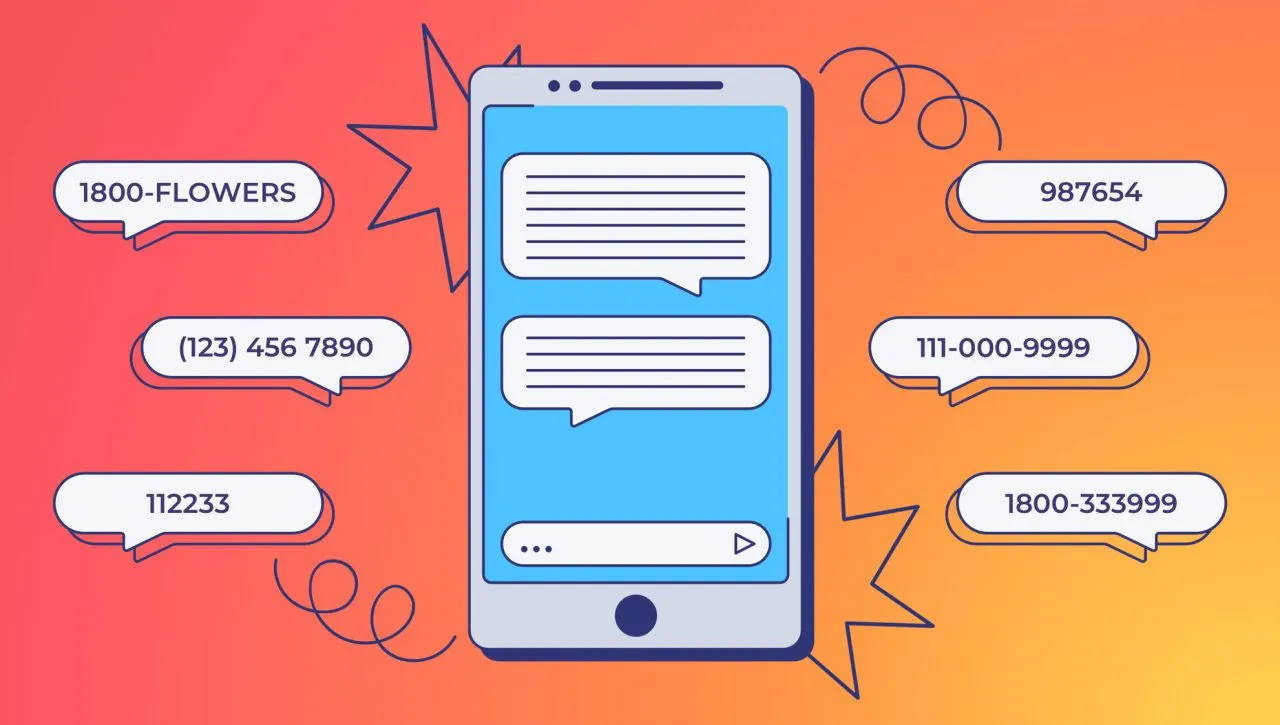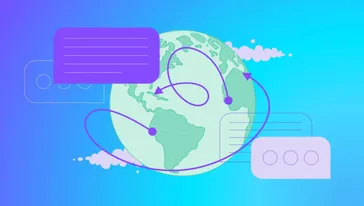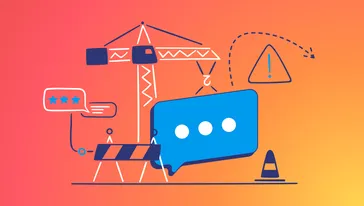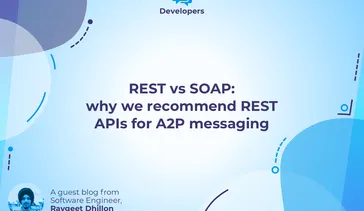Sick of trying to navigate through the businesstexingwafflehuffle?
We’ve rounded up all of the key SMS terms so you don’t have to go searching. Yee-ha.
Let’s get you ready to learn the lingo, start sending and kick back as you enjoy the benefits of SMS.
Businesstextingwafflehuffle might not be a real word. But all of the words listed below are.
A business texting: glossary

10DLC (10 Digit Long Code):
A standard 10-digit phone number in the US used for both personal and business messaging. It’s one of the primary methods for sending business SMS in the US. 10DLCs are versatile and affordable with a small monthly fee. Read our complete guide to 10DLCs.
API (Application Programming Interface):
Allows two different software systems to communicate and interact with each other. SMS APIs allow businesses to integrate SMS functionality into their existing software applications or websites. APIs are mostly used by developers or anyone who wants to build a custom solution.
See the ClickSend SMS API.
Alpha tags:
Short, alphanumeric labels used as sender IDs for SMS messages. Alpha tags are often used by businesses to brand their messages and increase recognition among recipients. Alpha tags are sometimes called business names. They’re between 3-11 characters long and can be letters and numbers.
Autoresponder:
An SMS message that is automatically sent in response to a specific trigger or event. Autoresponders can be used to automatically reply, provide instant support, or deliver automated follow-up messages.
Blacklist:
A list of phone numbers or contacts that have been flagged as undesirable or non-responsive. Businesses may maintain a blacklist to filter out inactive or uninterested recipients and improve the effectiveness (and reduce the cost) of their SMS campaigns.
Bulk SMS:
When a business sends a large volume of SMS messages simultaneously to a targeted audience. Bulk SMS is commonly used for promotional campaigns, announcements, and alerts.
Character limit:
The maximum number of characters allowed in a single SMS message. Standard SMS messages typically have a character limit of 160 characters or 80 characters if you use special characters like emojis.
You can send longer messages, but you are usually charged for every 160 characters you send.
Conversion rate:
The percentage of recipients who take a desired action (e.g., making a purchase, filling out a form) in response to an SMS message. Conversion rates are a key performance indicator used to measure the effectiveness of SMS campaigns.
Direct routes:
The most efficient and reliable paths for delivering SMS messages between sender and recipient. Direct routes ensure high delivery rates and minimal latency, making them ideal for time-sensitive or critical communications. Discover why you should send via direct routes vs grey routes.
DND (Do Not Disturb):
Regulations that allow individuals to opt out of receiving unsolicited marketing messages. Businesses must comply with DND regulations to avoid penalties and maintain customer trust.
Drip Campaign:
A marketing strategy that involves sending a series of SMS messages to leads or customers over time, typically at predetermined intervals. Drip campaigns are designed to nurture leads, educate customers, and drive conversions through targeted messaging.
Grey Routes:
Unofficial or unauthorised paths for delivering SMS messages that bypass official carrier networks. Grey routes may offer lower costs but can result in message delays, delivery failures, and compliance issues. Make sure you check that your SMS software uses direct routes.
Keyword:
A specific word or phrase that individuals can text to a designated number to initiate a predefined action, SMS automation or subscription. Keywords are often used in marketing campaigns to encourage engagement and opt-ins
MMS (Multimedia Messaging Service):
Unlike SMS, which only supports text, MMS allows users to send multimedia content such as images, videos, and audio files via mobile networks.
Message personalisation:
The practice of tailoring SMS messages to individual recipients based on their preferences, behaviour, or demographic information. Personalised messages can include recipient names, past purchase history, and other relevant details to enhance engagement and relevance.
Message scheduling:
The ability to specify a date and time for sending SMS messages in advance. Message scheduling allows businesses to plan and automate message delivery at optimal times for maximum impact and audience engagement.
Opt-in form:
A web-based or physical form used to collect consent from individuals who wish to receive SMS messages from a business.
Opt-in forms typically include fields for capturing contact information and explicit consent for receiving communications.
Opt-ins are really important if you’re sending SMS. Especially if you’re sending Marketing SMS.

Opt-out mechanism:
A process or method that allows recipients to unsubscribe or opt out of receiving SMS messages from a business. Opt-out mechanisms must be easily accessible. If a customer opts out, you must action their request to comply with regulations and maintain recipient trust.
With ClickSend, our software automatically actions any opt-outs for you. So, it’s too easy.
Personalisation:
The practice of customising SMS messages with recipient-specific information such as their name, location, or past interactions. Personalised SMS messages can improve engagement and conversion rates by making recipients feel valued and understood.
Segmentation:
The process of dividing a target audience into distinct groups based on specific criteria such as demographics, behaviour, or preferences. SMS segmentation allows businesses to send tailored messages to different audience segments for improved relevance and effectiveness.
Shortcode:
A unique 5-6 digit code used by businesses for sending branded SMS messages. While setup costs may be higher, shortcodes offer faster delivery, no daily sending limit and great branding potential. These are sometimes called dedicated shortcodes or DCS.
SMS analytics:
The collection, analysis, and interpretation of data related to SMS campaigns and messaging activities. SMS analytics provide insights into message delivery rates, open rates, click-through rates, and other metrics to optimise campaign performance.
SMS campaign:
A coordinated series of SMS messages designed to achieve specific marketing or communication objectives. SMS campaigns may include promotional offers, product announcements, event reminders, and other targeted messaging initiatives.
SMS compliance:
The adherence to regulatory guidelines and industry standards governing the sending and receiving of SMS messages. SMS compliance includes obtaining proper consent, honouring opt-out requests, and ensuring message content complies with relevant laws and regulations.
Your SMS provider should be able to help you with compliance. If they can’t help you, that’s a red flag. You should look for platforms that have high compliance standards, like ClickSend, to make sure your SMS get delivered.
SMS gateway:
A technology platform or service provider that facilitates the sending and receiving of SMS messages between mobile devices and computer systems. ClickSend is an example of an SMS gateway. We offer APIs, message routing, delivery reporting and so much more.
SMS integration:
The process of connecting SMS messaging capabilities with other software systems or platforms, such as CRM software, e-commerce platforms, or marketing automation tools. SMS integration enables seamless data exchange and workflow automation for improved efficiency and effectiveness.
Discover our integrations and see what’s possible with SMS.
SMS shortlink:
A shortened URL that directs recipients to a specific web page or landing page related to an SMS message. SMS short links conserve character space and improve message readability while facilitating click tracking and analytics.
Want to know more? Read the complete guide to links in texts.
Smishing:
A form of phishing scam that involves fraudulent SMS messages sent to deceive recipients into disclosing personal information or performing financial transactions. Smishing attacks often mimic legitimate communications from banks, retailers, or government agencies.
Transactional SMS:
Messages conveying essential information related to a specific transaction, such as order confirmations or appointment reminders. Transactional SMS are often triggered by customer actions, for example making a purchase online. They provide timely updates and enhance the overall customer experience.
See the difference between marketing versus transactional SMS.
Two-way SMS:
A communication method that allows for bidirectional messaging between businesses and their customers. With two-way SMS, recipients can respond to messages, enabling interactive conversations and feedback collection.
Start using your new lingo
Hopefully you’ve learnt a lot about SMS by now. You should be ready to use your new business SMS lingo. Try out your new vocabulary with a free 14-day trial of ClickSend.
Sign up for a free trial today and send your first SMS.



